We offer a wide range of preventive and restorative services.
A beautiful smile is the first thing people notice about you.You can trust us with the health and beauty of your smile. At Space Center Dental you will be treated as family. More convenient after- work appointments, extended hours and Saturday appointments.
Bridges & Crowns
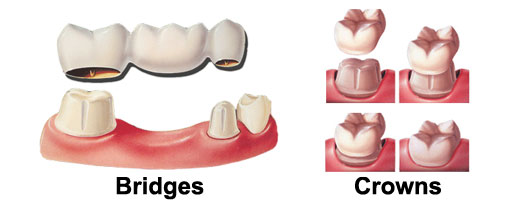
What are Dental Crowns and Tooth Bridges?
Both crowns and most bridges are fixed prosthetic devices. Unlike removable devices such as dentures, which you can take out and clean daily, crowns and bridges are cemented onto existing teeth or implants, and can only be removed by a dentist
How do Bridges Work?
A bridge may be recommended if you’re missing one or more teeth. Gaps left by missing teeth eventually cause the remaining teeth to rotate or shift into the empty spaces, resulting in a bad bite. The imbalance caused by missing teeth can also lead to gum disease and temporomandibular joint (TMJ) disorders.
Bridges are commonly used to replace one or more missing teeth. They span the space where the teeth are missing. Bridges are cemented to the natural teeth or implants surrounding the empty space. These teeth, called abutments, serve as anchors for the bridge. A replacement tooth, called a pontic, is attached to the crowns that cover the abutments. As with crowns, you have a choice of materials for bridges. Your dentist can help you decide which to use, based on the location of the missing tooth (or teeth), its function, aesthetic considerations and cost. Porcelain or ceramic bridges can be matched to the color of your natural teeth.
How do Crowns Work?
A crown is used to entirely cover or “cap” a damaged tooth. Besides strengthening a damaged tooth, a crown can be used to improve its appearance, shape or alignment. A crown can also be placed on top of an implant to provide a tooth-like shape and structure for function. Porcelain or ceramic crowns can be matched to the color of your natural teeth. Other materials include gold and metal alloys, acrylic and ceramic. These alloys are generally stronger than porcelain and may be recommended for back teeth. Porcelain bonded to a metal shell is often used because it is both strong and attractive.
Your dentist may recommend a crown to:
- Replace a large filling when there isn’t enough tooth remaining
- Restore a fractured tooth
- Attach a bridge
- Cover a dental implant
- Cover a discolored or poorly shaped toothCover a tooth that has had root canal treatment
Routine Cleaning
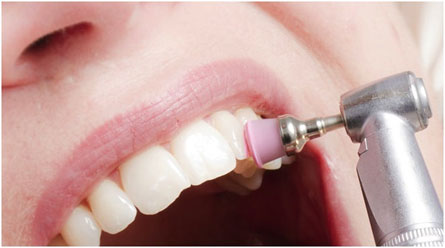
Getting your teeth cleaned is an important part of oral hygiene. To maintain your oral health, a professional cleaning is recommended at least twice a year. It’s important that you stick to this regimen so that you can stay up-to-date on the condition of your teeth. Professional cleanings remove tarter, plaque and stains that have accumulated on your teeth; this buildup occurs even with routine brushing. At Space Center Dental we are committed to providing you with A comfortable, pleasant dental experience.
Good, consistent oral hygiene helps prevent cavities and gum disease. At your appointment we are also able to look for abnormalities in the mouth that may be signs of oral cancer. If any problems are detected, we want to be able to treat them as soon as possible to avoid the development of more serious issues.
Teeth Whitening

Advantages of In-Office Whitening
No other teeth whitening procedure produces faster results. This is the safest form of teeth bleaching.
Gum and tooth sensitivity (formerly drawbacks to in-office bleaching) are more controllable today due to thicker peroxide gels (that don’t soak into the teeth as much as previous gels) and the use of desensitizers such a potassium nitrate and fluoride.
The whitening agent is applied as a gel placed in a mouthpiece or as a strip that sticks to your teeth. Over-the-counter mouthpieces fit less securely than the kind you get from your dentist.
Nitrous Oxide
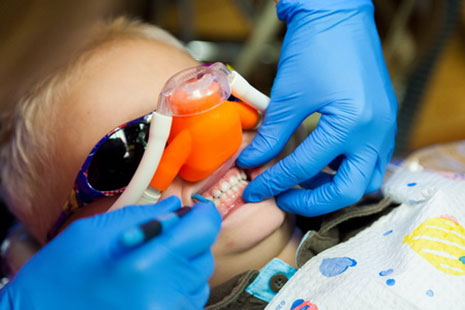
What is Nitrous oxide?
Nitrous oxide (N2O) is simply a gas which you can breathe in. It has no color, smell, and doesn’t irritate. Nitrous oxide/oxygen is a blend of two gases- oxygen and nitrous oxide.
If you’ve ever been to the dentist (and hopefully you have), you’re probably familiar with nitrous oxide. Often called laughing gas . Nitrous oxide is provided during dental procedures to relieve dental anxiety in both children and adults.
Before receiving dental treatment, A fitted mask is placed over the nose, and as the patient breathes normally, uptake occurs through the lungs. This allows the dentist to work on the mouth uninterrupted. At the end of treatment, Nitrous oxide is eliminated after a short period of breathing oxygen and has no lingering effects.
What Are the Benefits of Having Nitrous Oxide During Dental Treatment?
- Nitrous Oxide can make you feel more comfortable during your appointment
- You remain conscious and are fully aware during treatment
- The depth of sedation can be varied throughout your treatment as required
- Your gag reflex and flow of saliva are somewhat decreased
- Nitrous Oxide can reduce the discomfort or anxiety associated with an injection of local anesthesia; in some cases (particularly with small children) it takes the place of an injection altogether
- Most importantly, it helps to eliminate fear and reduces anxiety by helping you relax
Dentures & Partials
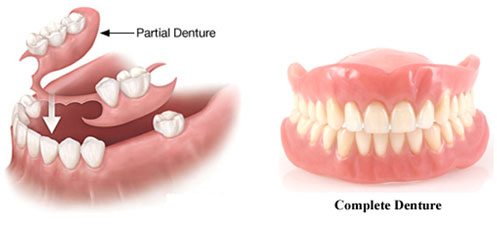
Conventional Full Denture
A conventional full denture is placed in your mouth after any remaining teeth are removed and tissues have healed. Healing may take several months, during which time you are without teeth.
Immediate Full Denture
An immediate full denture is inserted immediately after the remaining teeth are removed. (Your dentist takes measurements and makes models of your jaw during a prior visit.) While immediate dentures offer the benefit of never having to be without your teeth, they must be relined several months after being inserted. The reason is that the bone supporting the teeth reshapes as it heals, causing the denture to become loose.
Partial Denture
A partial denture rests on a metal framework that attaches to your natural teeth. Sometimes crowns are placed on some of your natural teeth and serve as anchors for the denture. Partial dentures offer a removable alternative to bridges.
How Long Before I Get Used to My Dentures?
New dentures may feel awkward or uncomfortable for the first few weeks or even months. Eating and speaking with dentures might take a little practice. A bulky or loose feeling is not uncommon, while the muscles of your cheeks and tongue learn to hold your dentures in place. Excessive saliva flow, a feeling that the tongue does not have adequate room, and minor irritation or soreness are also not unusual. If you experience irritation, see your dentist.
Scaling and Root Planning

The initial stage of treatment for periodontal disease is usually a thorough cleaning that may include scaling and root planning. The objective of these non-surgical procedures is to remove etiologic agents such as dental plaque and tartar, or calculus, which cause gingival inflammation and disease. Scaling and root planning can be used as a stand-alone treatment, or a preventative measure. They are commonly preformed on cases of gingivitis and moderate to severe periodontal disease.
Extractions

Natural teeth are ideal for biting, chewing and maintaining mouth and jawbone structure, which is why a dentist’s priority is to help restore, save and repair your natural teeth. However, sometimes a tooth extraction is unavoidable.
Dr.Tavakkoli at Space Center Dental will make sure you’re comfortable before, during, and after your extraction procedure. This includes walking you through every step of the tooth extraction, as well as the use of local anesthetics.
Feeling uneasy about your tooth extraction? Be sure to talk to us about how you’re feeling so that we can help.
Root Canals
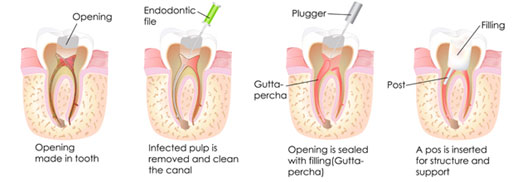
A root canal treatment is performed if you have an infection in the core of your tooth. Common symptoms include sore and swollen gums, toothache, pain when eating or drinking, and facial swelling. Despite common concerns a root canal treatment is not painful, and a timely treatment can save a tooth that might otherwise have to be removed completely. A dentist or orthodontist will perform the procedure, using local anaesthetic. After the root canal treatment your dentist will monitor the tooth for up to four years to ensure the infection does not return.
If you are suffering from any of the following symptoms, it could be sign of an infected pulp:
- Sore and swollen gums.
- Toothache.
- Pain when eating or drinking.
- Facial swellings.
This infection cannot be treated by antibiotics so it is recommended that you visit your dentist for an accurate diagnosis of your problem.
Composites
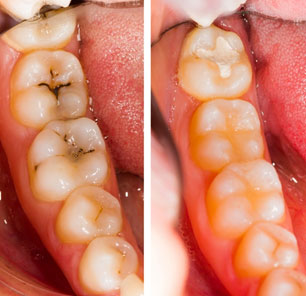
What is a Composite Resin (White Filling)? A composite filling is a tooth-colored plastic and glass mixture used to restore decayed teeth. Composites are also used for cosmetic improvements of the smile by changing the color of the teeth or reshaping disfigured teeth.
Resin composite fillings are made of ceramic and plastic compounds. Because resins mimic the appearance of natural teeth, these fillings have been used in front teeth for years. When they first appeared, however, resin compounds weren’t strong enough to be used in back teeth, where high-pressure grinding and chewing require greater durability.
